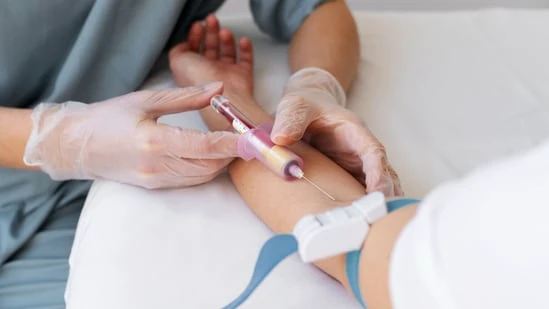Dr Bimal Chhajer, a cardiologist specialising in non-invasive cardiology, in a June 20, 2025 blog on his website, Saaol.com highlighted ‘top 10 blood tests for heart patients in non-surgical heart disease treatment’.
An excerpt from the blog read, “What if you could avoid bypass surgery? What if you could reverse heart disease without trauma? That’s no fantasy.” Cardiologist reveals ‘blood test that predicts heart attacks and could save your life’: ‘It’s not cholesterol’
It added, “This is not just your average-looking health blog. It’s the cheat code that no one ever gave you, the top 10 blood tests that can whisper the secrets of your heart’s future. You don’t need an OT to save your heart – you need better science and early detection, and the right questions.”
To avoid bypass surgery, consider the following blood tests recommended by the cardiologist:
1. hs-CRP (High-sensitivity C-reactive protein):
According to Dr Chhajer, “hs-CRP is a protein made by the liver when there’s inflammation in the body. hs-CRP doesn’t measure fat, but it quantifies inflammation – the slow, silent fire inside your blood vessels. Even a small elevation (greater than 2.0 mg/L) indicates you might be ‘heading for a cardiac event’ despite all other reports appearing to be fine.”
2. Lp(a) – Lipoprotein(a)
“This is a type of cholesterol particle with an extra sticky protein attached (apolipoprotein(a)). Lipoprotein (a) or Lp(a) is genetically determined. No amount of diet, exercise, or statins affects it much. If your Lp(a) is high, your risk of early heart attacks is 4x higher, even with perfect cholesterol,” Dr Chhajer said.
3. ApoB – Apolipoprotein B
Dr Chhajer added, “ApoB is the protein that carries all atherogenic (plaque-forming) particles. If you know ApoB, you know your enemy precisely. LDL can be misleading. ApoB shows exactly how many harmful particles are in your blood.”
4. Homocysteine
Dr Chhajer said, “It is a natural amino acid in your blood that comes from eating protein. A high level of homocysteine is destructive to your arteries, like acid eating through steel pipes. If it’s above 15 µmol/L, your arteries could harden even before the age of 40.”
5. Fibrinogen
Fibrinogen is a blood plasma protein that helps form clots. Dr Chhajer explained: “Heart patients don’t just have to worry about blockages; they are at risk for clots that come out of nowhere. Fibrinogen is a clotting factor, and if it goes up, your risk of stroke and heart attack goes up.”
6. Fasting insulin and HOMA-IR
He added, “It is the level of insulin in your blood after not eating for 8-12 hours. You may have normal blood sugar, but still be on the road to heart disease. Insulin Resistance is the earliest sign. HOMA-IR is a calculation using fasting insulin and glucose that tells you how hard your body is working to stay ‘normal’.”
7. NT-proBNP -(N-terminal pro B-type natriuretic peptide)
Dr Chhajer said, “It is a hormone released by your heart when it’s stretched or stressed. If your NT-proBNP is elevated, your heart is under mechanical stress. This is crucial for diagnosing early heart failure, even before symptoms like breathlessness appear.”
8. Oxidized LDL – (OxLDL)
He said, “It is defined as the LDL cholesterol that has been damaged (oxidized) by free radicals. LDL is bad. But oxidized LDL? That is the form of cholesterol that triggers the immune system, causes foam cells, and creates the most dangerous plaques. Few labs in India perform this test, but this is one of the most accurate markers of early arterial damage.”
9. Microalbuminuria (Urine test)
Dr Chhajer shared, “It is defined as the presence of small amounts of albumin (a protein) in urine. Microalbumin in urine is a strong predictor of cardiovascular events. It means that your endothelium, the lining of your blood vessels, is leaking.”
10. Lipid particle size test
“It is a test that looks at the size and type of LDL cholesterol particles. LDL particles may be large and fluffy (less dangerous) or small and dense (more dangerous). Even if your LDL number looks good, the small, dense ones sneak into arteries and cause heart blockages,” according to Dr Chhajer.
